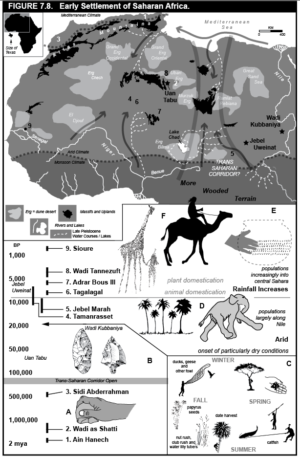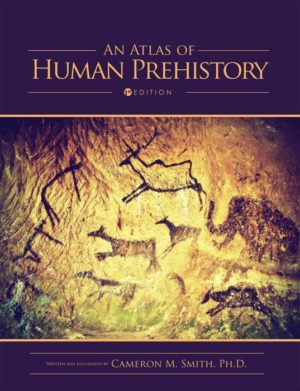
Editor’s Note: Recent research and excavations have uncovered evidence of very early prehistoric human occupation in locations or regions in the world long thought uninhabitable by humans in ‘deep-time’ history. Now, thanks to the painstaking research of new teams of scientists and archaeologists, we know early humans or hominins lived near ancient rivers and lakes that once dotted places like today’s Nefud and Sahara deserts, extending back hundreds of thousands of years. Here, author Cameron Smith summarizes what we know today about the early human occupation of the Sahara, a subject that has until now escaped the mainstream media and literature coverage of human prehistory.
Today characterized by an arid and windswept environment, the Sahara—largely comprising Africa North of the Congo Basin and West of the Nile river—only a few millennia ago was substantially wetter, supporting grassland animals. But even that grassy environment was temporary, a result of one of many such fluctuations over the past few million years [1].
The earliest archaeological evidence for hominin presence in the Sahara comes from the Ain Hanech formation, Algeria, where over 1,500 Oldowan stone artifacts have recently been re-dated to confirm a date on the order of c.1.78mya (see illustration below—A)*; symmetrical Acheulean items are also present, as are flora and fauna indicating a grassy, open woodland [2]; cutmarks on bone and smashed mammal bones also indicate animal butchery and marrow extraction at this early date [3].
The next well-dated site is found at the Wadi as Shatti, Eastern Lybia; here, both asymmetrical Oldowan and symmetrical Acheulean tools are known from many surface scatter sites [4], though for several reasons the assemblage is difficult to date beyond a general date of c.500,000BP-1mya.
The earliest undisputed Saharan hominin remains date to at least 500,000BP at Thomas Quarry, Morocco, also known as Sidi Abderrahmane. Fossil dentition here is found with the bones of many mammals including antelope, badger and seal (the site is not far from the seashore) [5].
A recently-discovered landscape ‘carpeted’ with a high density of stone tools and production debris dates to c.300,000-40,000BP (B) in the region of the Ubari Erg in lower Lybia, [6] spans the millennia around 120,000BP, when a Trans-Saharan Corridor—a watered, vegetated drainage cutting North-South through the West-Center Sahara—might have served as a route for the recently-evolved H. sapiens to move West and East from North-Central Africa [7]; while the corridor is generally accepted, as a major route out of Africa this is not yet as well-supported as the Nile-Levant corridor or the crossing from the Horn of Africa to South-Western Arabia.
Though there appears to be a Sahara-wide arid period from c.75,000BP-10,000BP, the Uan Tabu rockshelter West-Central Lybia (West of the Ubari Erg) dates as early as 60,000BP and contains some stylistic stone tool elements suggesting connections to the Nile region [8]. Particularly arid conditions persist through about 10,000BP, during which period human populations might have concentrated at the Mediterranean and Atlantic shores, and along the Nile, where a semi-sedentary mode of foraging has been noted at Wadi Kubbaniya at c.20,000BP (C). In any case, by 10,000BP there are rock art depictions of elephants in Western Lybia (D) and (wild) camel and horse herds at Tammanraset, Algeria, just West of center of the Sahara [9]. Late in the sequence at Jebel Marah (Sudan) there are evidences of animal domestication in the forms of cattle bones dating to c.10,000BP+ [10]. Not long after, plant domestication is inferred by pottery technology at Tagalagal (Algeria) (E) [11] and sickle gloss (representing the intensive cutting of vegetation) on stone tools at Niger’s Arar Bous III site at c.5,100+BP [12], with sorghum and millet being the most common Sahran domesticates [13].
High mobility–travel from oasis to oasis–has long featured in the Sahara, and by c.3,500BP bone chemistry analysis from burials at Wadi Tannexuft (Lybia) indicate non-local in-marriage of foreign women [14], ensuring genetic diversity and health. Such travel would have employed domesticated camels, indicated by a phlanx at Sioure (Senegal) dating to c.800BP [15], but their domestication might well have occurred earlier, as in the case of domesticated giraffes depicted at Jebel Uweinat (West of the Southern Nile) around 5,000BP (F).
Native Saharan cultural origins (e.g. Berber) have roots to over 2,000BP.
__________________________

__________________________
*[However, new evidence of stone tools were recently claimed to have been discovered at Ain Boucherit in Algeria, dated to 1.9 and 2.4 million years old].
Notes
[1] A superb online guide to Saharan history and archaeology can be found at Cambridge University’s ‘Desert Pasts’ site at http://www.human-evol.cam.ac.uk/desertpasts/resources_prehis_1.html.
[2] Pares, J.M. et al. 2014. Early Human Settlements in Northern Africa: Palaeomagnetic Evidence from the Ain Hanech Formation (Northeastern Algeria). Quaternary Science Reviews 99:203-209.
[3] Sahnouni, M. et al. 2013. The First Evidence of Cut Marks and Usewear Traces from the Plio-Pleistocene Locality of El-Kherba (Ain Hanech), Algeria: Implications for Early Hominin Subsistence Activities circa 1.8ma. Journal of Human Evolution 64:137-150.
[4] Lahr, M. et al. 2008. DMP III: Pleistocene and Holocene Palaeoenvironments and Prehistoric Occupation of Fazzan, Libyan Sahara. Lybian Studies 2008:1-32.
[5] Raynal, J-P. et al. 2010. Hominid Cave at Thomas Quarry 1 (Casablanca, Morocco): Recent Findings and Their Context. Quaternary International 223-224:369-382.
[6] Foley, R.A. and M.M. Lahr. 2015. Lithic Landscapes: Early Human Impact from Stone Tool Production on the Central Saharan Environment. PLOS One doi:10.1371/journal. pone.0116482.
[7] Osborne, A.H. et al. 2008. A Humid Corridor Across the Sahara for the Migration of Early Modern Humans out of Africa 120,000 Years Ago. Procedings of the National Academy of Sciences of the United States 105(43):16444-16447.
[8] Van Peer, P. 1998. The Nile Corridor and the Out-of-Africa Model: An Examination of the Archaeological Record. Cultural Anthropology 39:S115-140.
[9] Lajoux, J-D. 1962. The Marvels of Tassili N’Ajjer. Paris, Editions du chene.
[10] Marshall, F. and E. Hildebrand. 2002. Cattle Before Crops: the Beginnings of Food Production in Africa. Journal of World Prehistory 16(2):99-143.
[11] Haour, A.C. 2003. One Hundred Years of Archaeology in Niger. Journal of World Prehistory 17(2):181-234.
[12] See p.128 of #10 above.
[13] Wendorf, F. et al. 1992. Saharan Exploitation of Plants 8,000 Years BP. Nature 359:721-724.
[14] Tafuri et al. 2006. Mobility and Kinship in the Prehistoric Sahara: Strontium Isotope Analysis of Holocene Human Skeletons from the Acacus Mts (Southwestern Lybia). Journal of Anthropological Archaeology 25:390-402.
[15] MacDonald, Kevin C. and R.H. MacDonald 2000. The Origins and Development of Domesticated Animals in Arid West Africa. In Blench, R.M. and K.C. MacDonald. 2000. (eds),The Origins and Development of African Livestock: Archaeology, Genetics, Linguistics and Ethnography. 127–62. London: University College Press.
Cover image, top left: Araibia Amine, Wikimedia Commons
 From An Atlas of Human Prehistory by Cameron Smith. Copyright © 2019 by Cognella, Inc. Republished by permission.
From An Atlas of Human Prehistory by Cameron Smith. Copyright © 2019 by Cognella, Inc. Republished by permission.
Smith’s Atlas of Human Prehistory provides a very readable and broad overview of the evidence for the human prehistoric presence and journey across the globe. Readers who wish to purchase the volume may obtain it at the Cognella publisher website.





